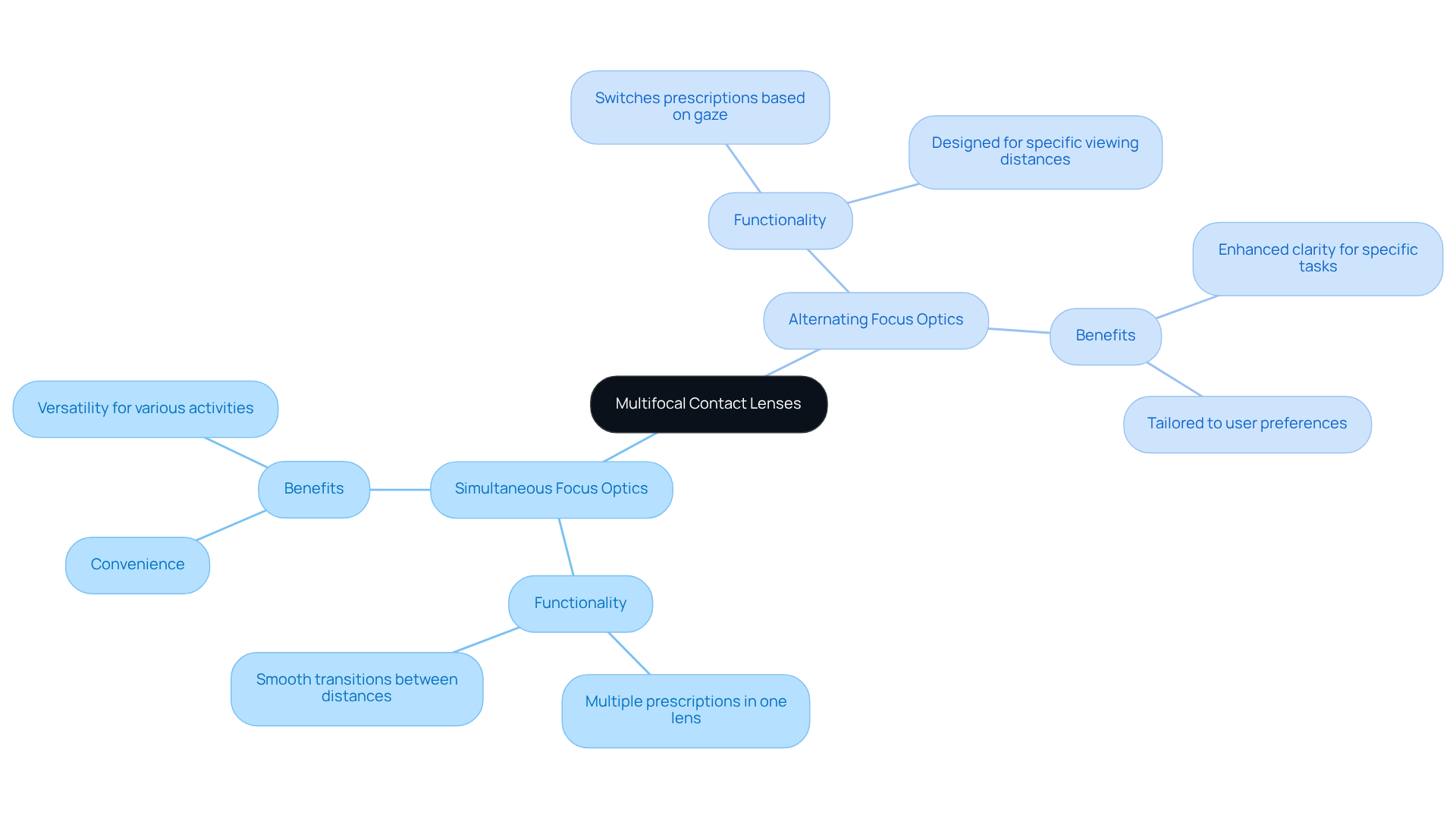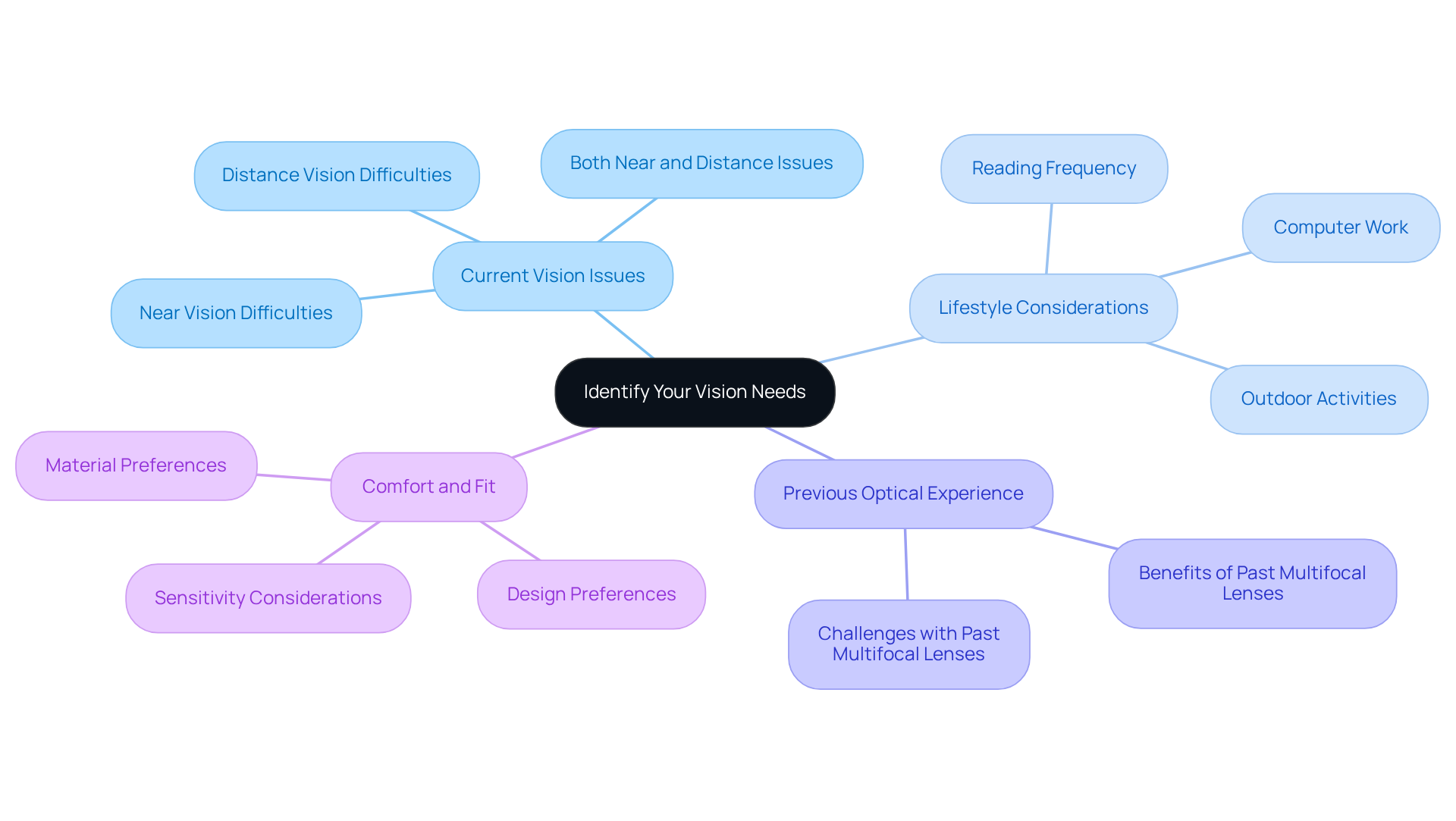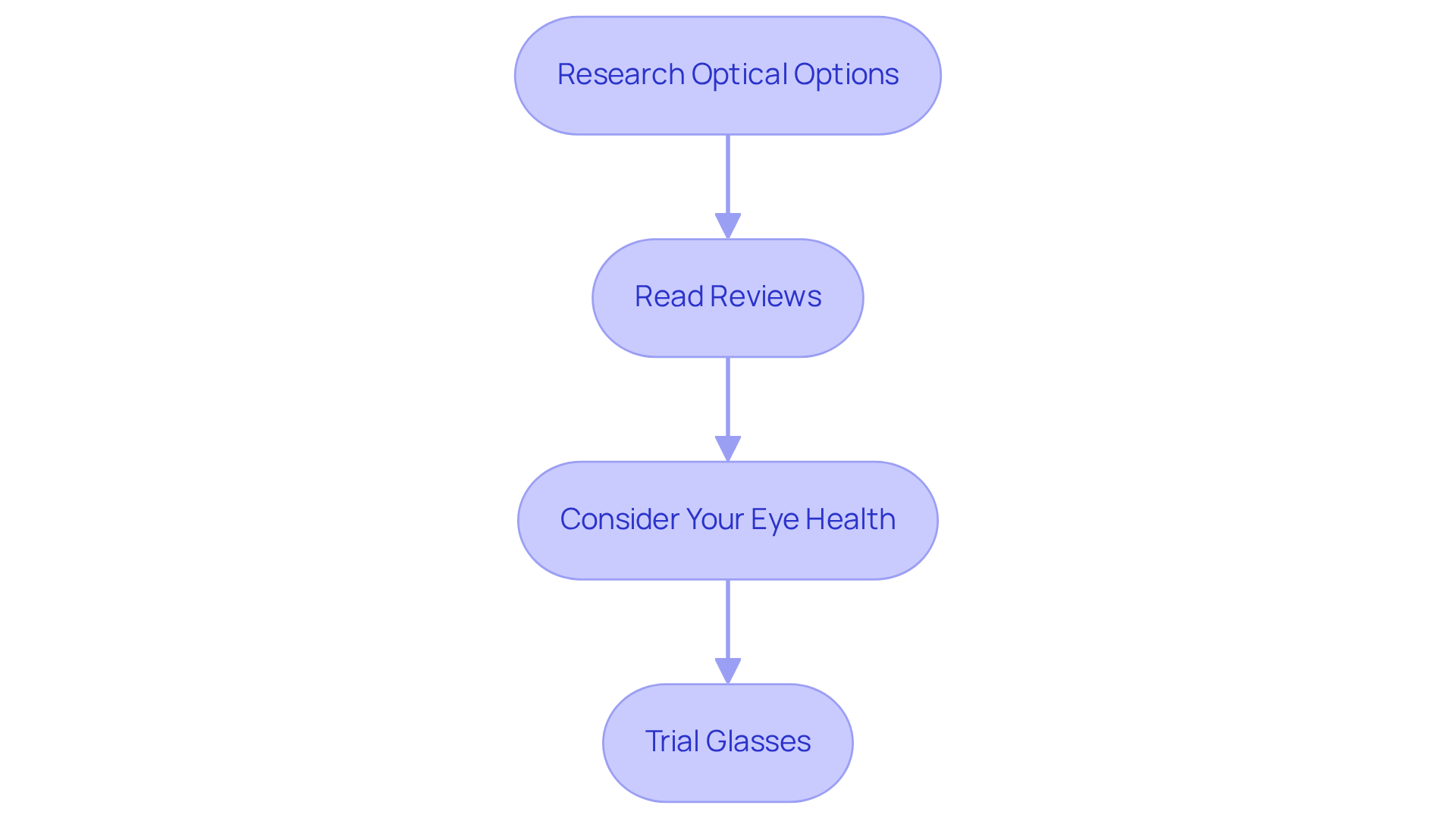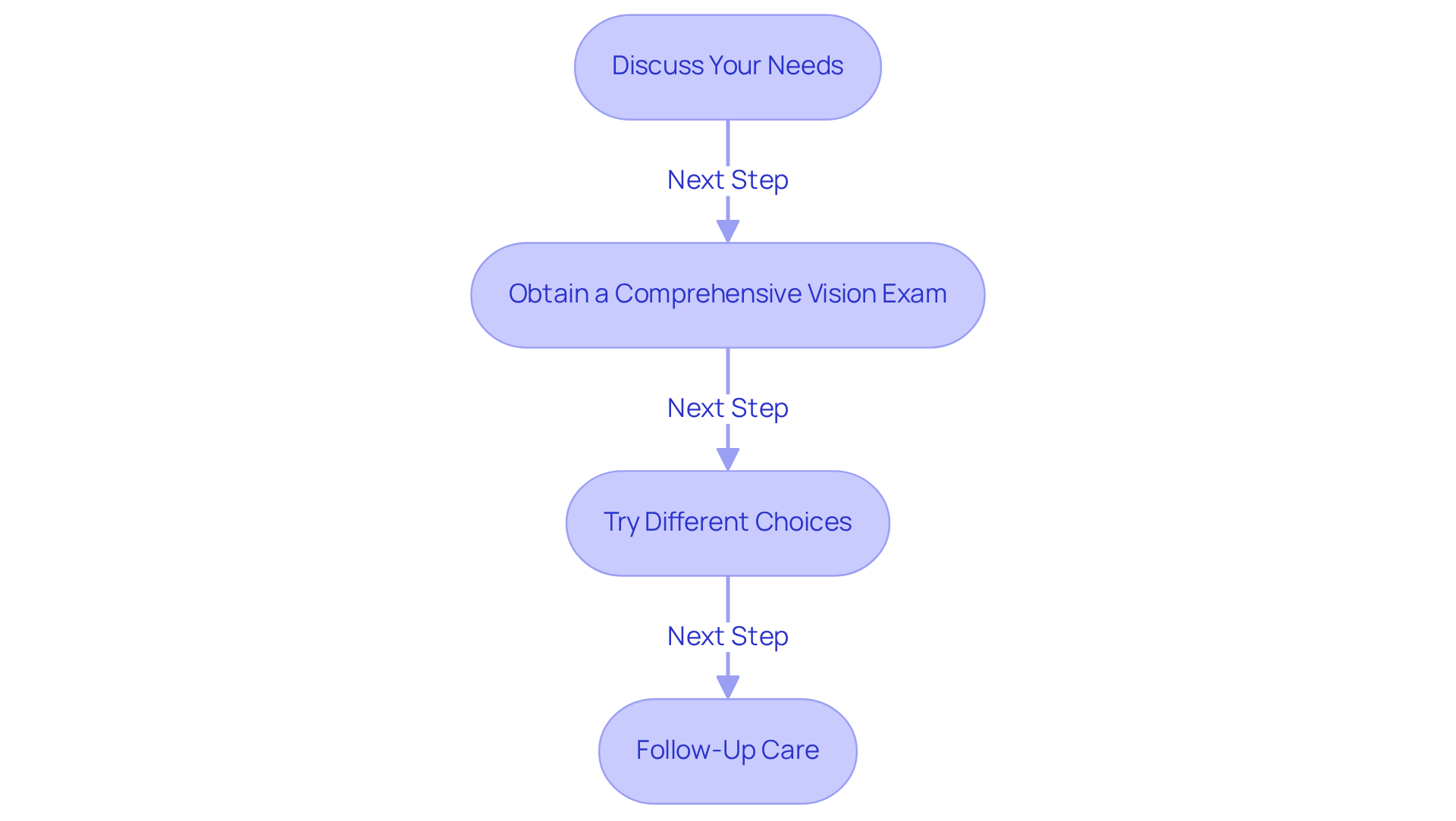Posted by: Northwest Eye in General on August 4, 2025
Overview
Choosing the right multifocal contact lenses can feel overwhelming, but we are here to help you through this process. It’s important to assess your vision needs, consider your lifestyle factors, and consult with an eye care professional who can guide you.
The article outlines a four-step process that emphasizes understanding your personal vision challenges. By researching lens options and ensuring proper fitting through professional guidance, you can achieve optimal comfort and effectiveness in vision correction. Remember, it’s common to have questions and concerns, and seeking help is a positive step towards better vision.
Introduction
Choosing the right multifocal contact lenses can feel like navigating a maze, especially for those experiencing the challenges of presbyopia. We understand that this journey can be overwhelming. These innovative lenses provide a solution by offering clear vision at various distances, yet the selection process can seem daunting.
This article explores essential steps to help you:
- Identify your individual vision needs
- Understand different lens types
- Consult with eye care professionals
Our goal is to empower you to make informed choices. What if the key to achieving optimal vision lies not just in the lenses themselves, but in understanding your personal requirements and seeking expert guidance? We are here to help you through this process.
Understand Multifocal Contact Lenses
Multifocal contact optics are created to assist you in seeing clearly at different distances, making them an excellent solution for individuals facing presbyopia, a prevalent age-related condition. We understand that adjusting to changes in vision can be challenging. These lenses typically feature distinct areas for near, intermediate, and far sight, allowing for smooth transitions between different focal points.
It is important to consider the two main types of multifocal optics:
- Simultaneous focus optics provide various multifocal prescriptions within a single lens.
- Alternating focus optics switch between prescriptions based on where you are looking.
Understanding these differences is crucial for selecting the right lens that fits your lifestyle and eye care needs.
We are here to support you in making an that enhances your vision and comfort. Remember, it’s common to have questions about which option is best for you, and we encourage you to reach out for guidance.

Identify Your Vision Needs
To effectively identify your vision needs, we encourage you to consider the following factors:
- Current Vision Issues: It’s important to assess whether you are experiencing difficulties with near vision, distance vision, or both. Understanding your specific challenges is essential for choosing the right perspective.
- Lifestyle Considerations: Reflect on how you spend your time. Do you find yourself reading frequently, working on a computer, or enjoying outdoor activities? Your daily habits can greatly influence the type of that will best meet your requirements.
- Previous Optical Experience: If you have worn multifocal lenses in the past, take a moment to assess your experience. What aspects did you find beneficial or challenging? This insight can be invaluable in guiding your discussions with your eye care professional.
- Comfort and Fit: Consider any sensitivities you may have regarding contact eyewear. Are there specific materials or designs that you prefer? Comfort is crucial for long-term satisfaction with your eyewear.
By reflecting on these aspects, you can express your needs more effectively during your consultation with an eye care expert, ensuring a customized approach to your eye care. Remember, as recent studies emphasize, addressing your sight requirements is more essential than comfort when it comes to multifocal lenses. Engaging with your eye care provider about your specific needs will help ensure that you receive personalized solutions that enhance your overall satisfaction. As Karen Walsh from CooperVision observes, progress in progressive eyewear designs aims to streamline the fitting process and guarantee that patients remain satisfied from day one. This commitment to patient education and tailored solutions is essential for achieving the best outcomes in your vision care.

Select the Right Multifocal Contact Lenses
We understand that the process of selecting can feel overwhelming. Here are some supportive steps to guide you:
- Research Optical Options: Explore the various brands and types of optics available in the market for multifocal use. Consider factors such as material, design, and wear schedule (daily, bi-weekly, or monthly). Knowing your options can provide reassurance in your choice.
- Read Reviews: It’s common to seek feedback from others. Check patient testimonials and experiences to assess the comfort and effectiveness of particular eyewear. Hearing from others can help ease your concerns.
- Consider Your Eye Health: If you have any pre-existing eye conditions, it’s crucial to ensure that the choices you make are suitable for your eye health. We care about your well-being, so take this into account.
- Trial Glasses: Many eye care providers offer trial glasses. This is a wonderful opportunity to evaluate comfort and clarity before making a final decision. Remember, it’s perfectly okay to take your time in finding what feels right for you.

Consult with an Eye Care Professional
After recognizing your sight requirements and selecting potential glasses, we understand that arranging a consultation with an eye care expert regarding multifocal options is a crucial next step. During this appointment, it’s important to focus on several key areas:
- Discuss Your Needs: Clearly communicate your requirements and lifestyle to the professional. This information is vital for personalized recommendations that cater to your unique situation.
- Obtain a Comprehensive Vision Exam: A detailed vision assessment is essential to ensure your prescription is precise and that your sight is healthy enough for contact use. Routine eye check-ups can identify hidden problems, such as dry eye syndrome or glaucoma, before they significantly affect your sight. This proactive approach is crucial for a successful eyewear experience.
- Try Different Choices: Your eye care professional might suggest experimenting with various types of glasses to find the most suitable option for your eyes and sight requirements. This trial phase is essential, as studies show that proper fitting can lead to a 92% success rate on the first visit.
- Follow-Up Care: It’s important to schedule follow-up appointments to monitor your comfort and vision quality. Routine examinations enable modifications when needed and assist in identifying any potential concerns early. This ensures long-term satisfaction with your multifocal eyewear. Remember, approximately 50% of contact wearers encounter visual disturbances, making continuous communication with your eye care specialist essential for addressing any issues. As Dr. David Jupiter emphasizes, “Regular eye health checkups are crucial for contact lens wearers to ensure optimal vision and prevent potential complications.” We are here to .

Conclusion
Choosing the right multifocal contact lenses is an important step in addressing the vision changes that often accompany age. We understand that this can be a daunting process, but by becoming familiar with the different types of multifocal optics and clearly identifying your personal vision needs, you can make informed decisions that enhance your daily visual experiences. This journey not only involves research and selection but also highlights the importance of consulting with eye care professionals to ensure a personalized approach to your eye health.
Key considerations, such as your current vision challenges, lifestyle factors, and previous experiences with eyewear, play a significant role in the selection process. Engaging in thorough discussions with eye care experts, obtaining comprehensive vision exams, and being open to trial options can lead to a successful fitting and improved satisfaction with multifocal lenses. Moreover, regular follow-up care is essential in monitoring your comfort and addressing any potential issues that may arise.
Ultimately, the journey to finding the perfect multifocal contact lenses is a collaborative effort that prioritizes your individual needs and preferences. By taking the time to explore options, seek professional guidance, and remain proactive about your eye health, you can enjoy clearer vision and greater comfort in your everyday life. Embracing this approach not only enhances visual clarity but also contributes to your overall well-being. It is essential for anyone experiencing vision changes to take action and seek the right solutions, and we are here to help you through this process.
Frequently Asked Questions
What are multifocal contact lenses designed for?
Multifocal contact lenses are created to assist individuals in seeing clearly at different distances, making them an excellent solution for presbyopia, a common age-related condition.
How do multifocal contact lenses work?
These lenses feature distinct areas for near, intermediate, and far sight, allowing for smooth transitions between different focal points.
What are the two main types of multifocal optics?
The two main types are simultaneous focus optics, which provide various multifocal prescriptions within a single lens, and alternating focus optics, which switch between prescriptions based on where you are looking.
Why is it important to understand the differences between the types of multifocal optics?
Understanding these differences is crucial for selecting the right lens that fits your lifestyle and eye care needs.
What should I do if I have questions about choosing multifocal contact lenses?
It is common to have questions about which option is best for you, and you are encouraged to reach out for guidance to make an informed choice that enhances your vision and comfort.






